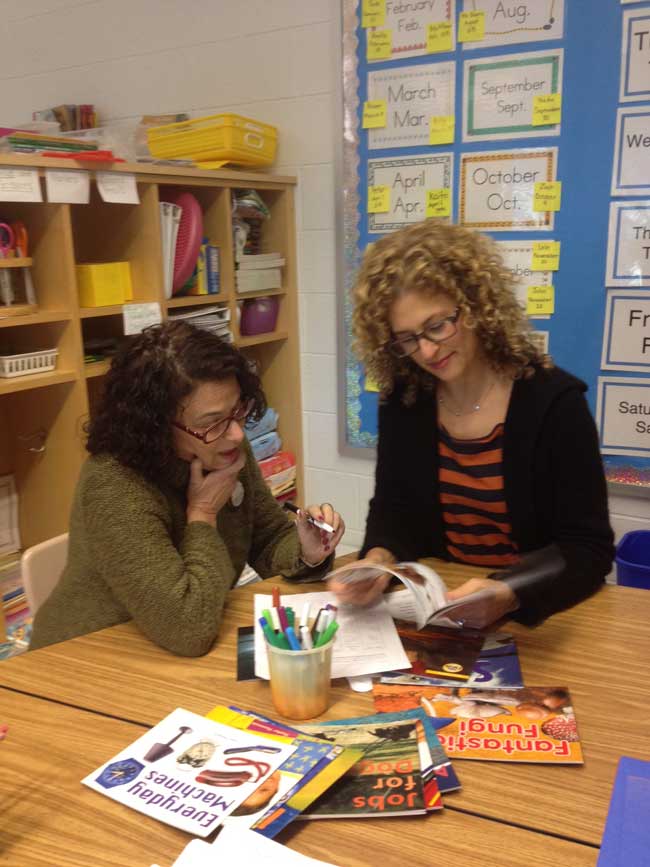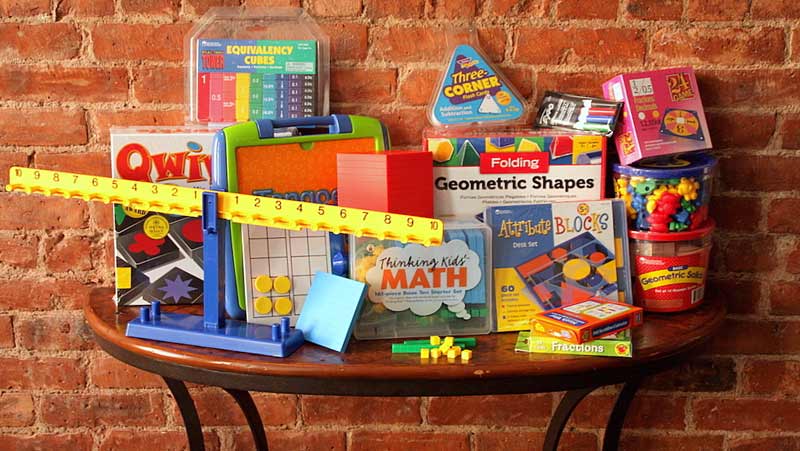 Do you know your child’s reading level? Benchmarking elementary reading levels is important in order to help students identify and practice with “just right” texts. For instructional purposes, we want to be sure that a text isn’t too easy nor too hard (thus frustrating). Benchmarking reading levels and developmental stages of spelling is straightforward and doesn’t require any guessing. It allows educators and parents to transparently discuss progress and have a comparison against a grade level standard at a particular point in time. Hopefully your child’s teachers conducted running records and other classroom assessments — such as Gates-MacGinitie or Brigance testing — over the course of the school year, you’ve had an opportunity to discuss reading benchmarking at parent-teacher conferences, and you have a good idea as to the level that is “Just Right” for your child. So what exactly do the different levels represent?
Do you know your child’s reading level? Benchmarking elementary reading levels is important in order to help students identify and practice with “just right” texts. For instructional purposes, we want to be sure that a text isn’t too easy nor too hard (thus frustrating). Benchmarking reading levels and developmental stages of spelling is straightforward and doesn’t require any guessing. It allows educators and parents to transparently discuss progress and have a comparison against a grade level standard at a particular point in time. Hopefully your child’s teachers conducted running records and other classroom assessments — such as Gates-MacGinitie or Brigance testing — over the course of the school year, you’ve had an opportunity to discuss reading benchmarking at parent-teacher conferences, and you have a good idea as to the level that is “Just Right” for your child. So what exactly do the different levels represent?
Benchmarking Elementary Reading Levels, A through Z:
Level A Books
It is recommended that children begin at this level once they have some familiarity with print and directionality (we read English from left to right). Full knowledge of all letter sounds is not necessary. These books include picture books with simple labels and captions, often 5-6 words per page, or one line. There is ample space between words, and typically repeating language.
Level B Books
These books have very simple story lines, or focus on one individual idea. They usually have one or two lines of print on a page, but sentences and punctuation is more varied than A Level books. Repeating patterns are seen again, and the written words correspond directly to the illustrations.
Level C Books
Stories at this level have simple story lines and are based upon topics that are familiar to children. For the most part they have more words and lines of print than A or B Level books, again include repeated patterns, and as new, more complex patterns are introduced throughout, children cannot simply predict the next page’s text. Sight-words, also known as high-frequency words, and easily decodable words are found at this level.
Level D Books
Slightly more complex these readers begin to introduce less concrete, more abstract or unfamiliar ideas to children. The word count in sentences is longer, and words are now carried over from one page, or more. Words at this level may include multisyllabic and compound words. Whereas earlier levels offer very strong correlation between word and picture, at this level, children cannot only rely on illustration to guess at the print.
Level E Books
More lines of text per page, and more pages per book characterize words at this level.
Words cross over pages, and new types of punctuation are introduced. The story lines are more sophisticated, and non-fiction books may include more difficult concepts (although at this level repeating language is still offered for support). Higher level multisyllabic and compound words are included.
Level F Books
>These narrative texts have more episodes in the story. More complex and varied language patterns are also introduced, with shorter text. For the first time, abstract concepts that require children to use higher-thinking skills are present. Text is now presented in smaller font, and more lines of print per page. English punctuation in all form is seen at this level, along with a variety of more sophisticated high-frequency words.
Level G Books
At this level, books are no longer repetitive, and new patterns are introduced. Vocabulary becomes higher-level, and in non- fiction, vocabulary becomes very challenging, requiring some background knowledge. Text layout and font may become more complex, and illustrations no longer give clear indication of corresponding text.
Level H Books
These readers are very similar to the preceding level, but for the first time, no longer is simple prose the only text; poetry and figurative language are introduced, and repetitive patterns are not as common. Spoken language is no longer used exclusively, and written language is integrated and provides more sophisticated content, requiring closer attention to word patterns.
Level I Books
Books are this level are longer and the concepts presented are more complex than at earlier levels. The font is not as large, and word-attack skills begin to be called for, as text becomes increasingly complex. Fiction and non-fiction books at this level are numerous; fiction becomes more complex in plot and depth, and non-fiction includes technical, high-level language. Although pictures may illustrate the text, they no longer offer much support in terms of decoding text.
Level J Books
Books at this level are very similar to I Level books, but content becomes considerably more challenging. Chapter books are introduced that present complex characters and books now have very few illustrations. New vocabulary is presented in both fiction and non-fiction text.
Level K Books
At this level, narrative text begins to include multiple plots, and writing styles vary. Technical language and new, more difficult concepts are included in non-fiction.
Level L Books
The readers at this level are very similar to K Level books, except that they are longer and many informational picture books in the non-fiction category are available. In fiction, chapter books increase in complexity in terms of plot lines and character development. Higher- level thinking is called for in the area of abstract concepts and symbolism.
Level M Books
These books are generally set in much smaller font, and vocabulary and concepts are more complex, calling upon strong background knowledge for comprehension.
Level N Books
At this level, children are taken to new levels of writing, as text expands to include new genres, and writing style becomes more sophisticated. More abstract thinking is called for, as literary writing styles begin to expand, and call for students to use more of their imagination.
Level O Books
More complex vocabulary and themes are typical of writing at this level, and abstract thinking is required in narrative text. Interesting, complex characters are introduced, and students again, must expand upon their own world to understand and study the lives of others.
Level P Books
These books offer more complex language and informational texts. Varied organization in layout is present, and new genres are introduced. Books specifically geared toward early adolescents are now included.
Level Q Books
Books now require more interpretive skills, and structures and words are more difficult and complex. Words from other languages are now present, and longer texts require extended reading. Vocabulary is increasingly sophisticated and challenges the reader at this level.
Level R Books
At this level, fiction and non-fiction introduce varied historical periods and time settings. Again, vocabulary builds in sophistication and requires increasing interpretive skills.
Level S Books
Books at this level reflect a wide variety of genres. Readers are often required to make text to text comparisons and contrasts as they remember other material that they have read. Sentences and paragraphs are increasingly complex, and words are figurative and less literal than before.
Level T Books
At this level, figurative language becomes increasingly complex, and vocabulary is yet more challenging. Students at this level must be able to sustain longer periods of reading as chapter books at this level become increasingly longer.
Level U Books
At this level, readers are essentially approaching adult -level reading. Complex themes and multiple story lines characterize these texts. Symbolism is frequent at this level, bound collections of stories are seen, and plots and sub-plots are common.
Level V Books
Books at this level beckon the reader to bring deeper background knowledge to the reading experience. Vocabulary is much more sophisticated, and deeper, implicit messages by the author require the reader to use abstract thinking skills. Strong themes are present at this level, and literary styles become more sophisticated. At this level, science fiction is introduced.
Level W Books
This level introduces themes that are increasingly dark and challenge readers to relate to characters in difficult situations. Font is small, and readers will need an awareness of society and politics in order to fully understand the themes in the text. Inferential thinking is required, and readers need to be sufficiently sophisticated in symbolic interpretation in order to gain optimal understanding of text.
Level X Books
Fantasy is a strong theme at this level, as students need to increasingly draw inferences and compare text to other works that they have read. Symbolism is used extensively at this level, and students must interpret meaning accordingly. Topic, language and vocabulary have become very sophisticated.
Level Y Books
These books include many social problems as themes, along with more numerous and mature details. Readers are required to think way beyond the literal meaning of text. They will need extensive background information to fully comprehend the text, and will be required to integrate new information gleaned from the text with all that they already know. The ability to read critically is required at this level.
Level Z Books
Similar to Level Y books, these readers present more mature themes, some controversial and complex. Non-fiction offers very technical and challenging material, and readers need to read critically and to evaluate new information. Complex themes within genres are present, and in non-fiction, more elaborate and new text layouts are used. Existentialist themes are present at this level, pushing readers to consider very mature concepts and universal truths.
We make use of the Teachers College Columbia University Reading and Writing Project to benchmark elementary reading levels on a quarterly basis. It’s best not to get hung up on a single exit level for June but rather to think about reading levels in bands of two to three alpha letters. Performance with fiction and nonfiction texts may differ, and writing response work needs to be factored into benchmarking, particularly as students move into grades 2, 3, 4, and 5.
By Polly Goltche, Reading Specialist
 One of the most awe-inspiring processes to watch unfold is the vocabulary development of a young child. From the first utterance of “ball,” “mama,” or “more,” children are off and running, word wise. They are literal vocabulary sponges, growing their word bank exponentially in their first five years of life, typically using over 2,000 words in their everyday conversation by the time they walk through the doors of a school building. Not only that, but children understand that much more than they are able to express and have a receptive vocabulary ten times as large as their expressive word bank. A young child’s vocabulary just continues to grow through their school age years, as they acquire vocabulary through new experiences, interactions, and content. When asked how children have changed since starting school, parents often boast about their student’s vocabulary development, amazed at their ability to articulate ideas and express feelings with clarity and specificity.
One of the most awe-inspiring processes to watch unfold is the vocabulary development of a young child. From the first utterance of “ball,” “mama,” or “more,” children are off and running, word wise. They are literal vocabulary sponges, growing their word bank exponentially in their first five years of life, typically using over 2,000 words in their everyday conversation by the time they walk through the doors of a school building. Not only that, but children understand that much more than they are able to express and have a receptive vocabulary ten times as large as their expressive word bank. A young child’s vocabulary just continues to grow through their school age years, as they acquire vocabulary through new experiences, interactions, and content. When asked how children have changed since starting school, parents often boast about their student’s vocabulary development, amazed at their ability to articulate ideas and express feelings with clarity and specificity. Problems! Problems! They come in all sizes and types. Some people claim that all of life is a series of problems to be solved, from the simplest (orange juice or milk for breakfast?), to much bigger (what occupation shall I pursue?), to the really big ones (how shall we achieve world peace?). When approaching a math problem, there are some important preliminary steps. First, it’s beneficial to know the standard math operations: addition, subtraction, multiplication, division, and their extended uses in working with common fractions, decimal fractions, time, money, and measurement. Having basic facts mastered and readily at hand is unquestionably helpful and necessary. But simply being able to calculate is not enough. Math is only truly useful when it is
Problems! Problems! They come in all sizes and types. Some people claim that all of life is a series of problems to be solved, from the simplest (orange juice or milk for breakfast?), to much bigger (what occupation shall I pursue?), to the really big ones (how shall we achieve world peace?). When approaching a math problem, there are some important preliminary steps. First, it’s beneficial to know the standard math operations: addition, subtraction, multiplication, division, and their extended uses in working with common fractions, decimal fractions, time, money, and measurement. Having basic facts mastered and readily at hand is unquestionably helpful and necessary. But simply being able to calculate is not enough. Math is only truly useful when it is  January is always an important check-in time for our families with
January is always an important check-in time for our families with  Code is the “newest foreign language” that students of all ages want to learn. But, even though we hear the words “Python” and “Java” being thrown around, most of us don’t really know what they mean or what the differences are. Here is our handy guide to the
Code is the “newest foreign language” that students of all ages want to learn. But, even though we hear the words “Python” and “Java” being thrown around, most of us don’t really know what they mean or what the differences are. Here is our handy guide to the